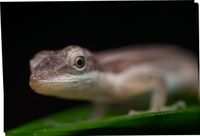Manual focus stacking
If too much movement occurs between the individual shots for focus stacking, the software is often overwhelmed with processing the data. This happens often when taking handheld photos in nature. A single image taken with high magnification usually has too little depth of field to deliver a satisfactory result, so that only manual stacking can help.
A single image from a series of ten images, only the tip of the anole lizard's nose is in focus.
The images automatically aligned with the software look very promising.
However, the automatic cross-fading of the individual focus areas creates a monster. The swinging leaf created too much movement.
In such a case, only manual intervention helps. To do this, the recipient image is selected into which the individual "snippets" of the other photos are inserted. Most of the time, this is the image with the focus at the back. Then the sharp areas of the photos are gradually cut out from back to front and inserted into the recipient image and brought into position with scaling and rotating. The overlapping areas are searched for at the edges and blended with the eraser and / or copier stamp tool. Ideally, the transitions are no longer visible and the stack cannot be recognized as such.
The recipient picture with inserted element from one of the donor photos (highlighted for clarity). The edges are faded and the other donor snippets are added one by one.
The finished result of the anole lizard with a continuous focus area from the tip of the nose to behind the eye. With a suitable starting material and with a little skill, the stack cannot be recognized as such.




